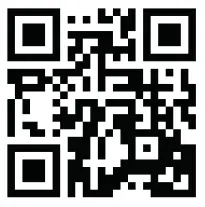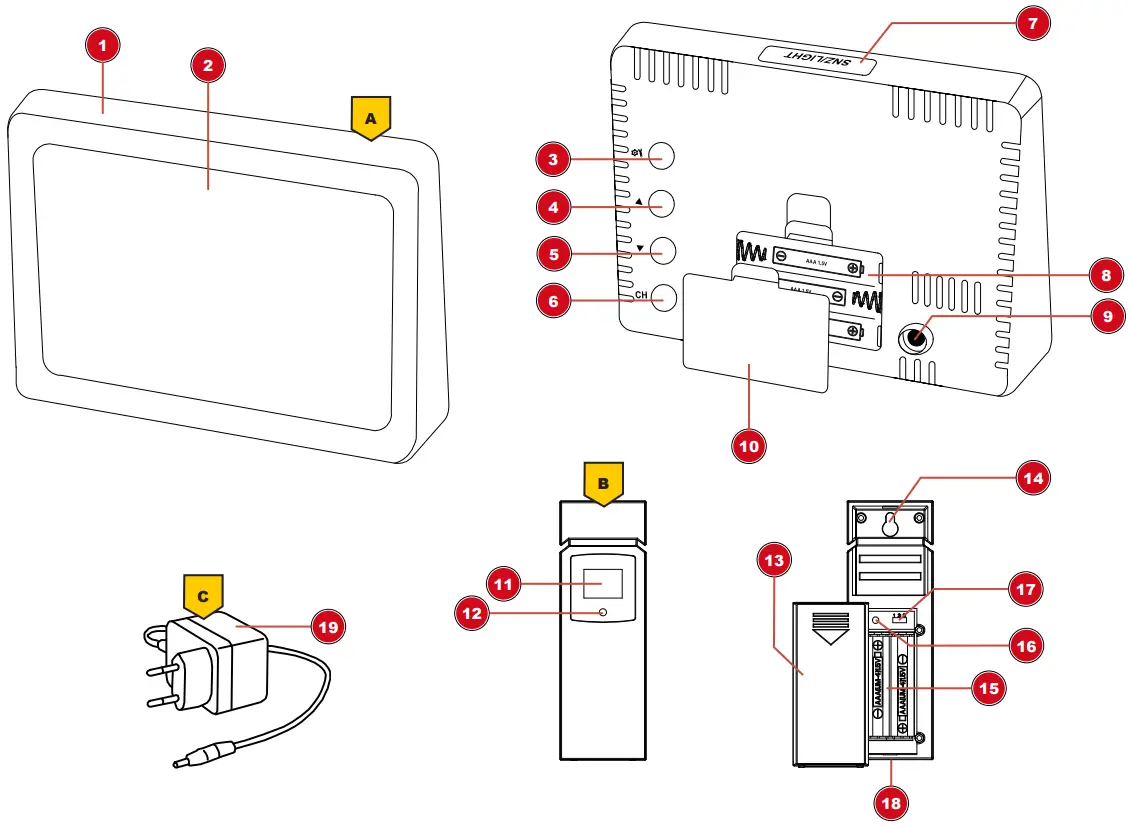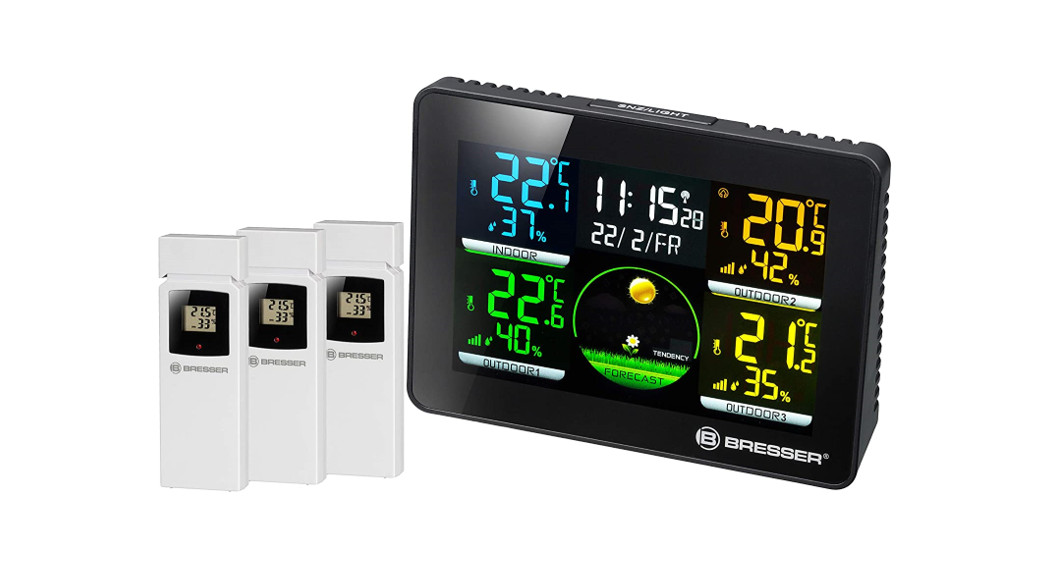

Weather StationThermo Hygro Quadro NLXInstruction manual
Visit our website via the following QR Code or web link to find further information on this product or the available translations of these instructions.
 http://www.bresser.de/P7000023
http://www.bresser.de/P7000023
![]() WARRANTY
WARRANTY
Imprint (German)
Bresser GmbHGutenbergstr. 246414 RhedeGermanywww.bresser.de
For any warranty claims or service inquiries, please refer to the information on “Warranty” and “Service” in this documentation. We apologize for any inconvenience caused by the fact that we cannot process inquiries or submissions sent directly to the manufacturer’s address. Errors and technical changes excepted.© 2021 Bresser GmbHAll rights reserved.The reproduction of this documentation – even in extracts in any form (e.g. photocopy, print, etc.) as well as the use and distribution by means of electronic systems (e.g. image file, website, etc.) without the prior written permission of the manufacturer is prohibited.The designations and brand names of the respective companies used in this documentation are generally protected by trade, trademark, and/or patent law in Germany, the European Union, and/or other countries.
Validity note
This documentation is valid for the products with the following article numbers: 7000023Manual version: 0521Manual designations: Manual_7000023_Thermo-Hydro-Quadro-NLX_en-de-fr-nles_BRESSER_v052021aAlways provide information when requesting service.
About this Instruction Manual
![]() NOTICE These operating instructions are to be considered a component of the device. Read the safety instructions and the operating manual carefully before using this device. Keep this instruction manual in a safe place for future reference. When the device is sold or given to someone else, the instruction manual must be provided to the new owner/ user of the product.
NOTICE These operating instructions are to be considered a component of the device. Read the safety instructions and the operating manual carefully before using this device. Keep this instruction manual in a safe place for future reference. When the device is sold or given to someone else, the instruction manual must be provided to the new owner/ user of the product.
General safety instructions
![]() DANGER Risk of an electric shock! This device contains electronic parts that are powered by a power source (AC adapter and/or batteries). Improper use of this product may result in electric shock. Electric shock can cause serious or fatal injuries. It is therefore imperative that you observe the following safety information.
DANGER Risk of an electric shock! This device contains electronic parts that are powered by a power source (AC adapter and/or batteries). Improper use of this product may result in electric shock. Electric shock can cause serious or fatal injuries. It is therefore imperative that you observe the following safety information.
![]()
- Never leave children unattended when handling the device! Follow the instructions carefully and do not attempt to power this device with anything other than power sources recommended in this instruction manual, otherwise, there is a danger of an electric shock!
- Disconnect the power supply by pulling the mains plug when the appliance is not in use, in case of a longer interruption of operation, and before any maintenance and cleaning work.
- Place your device so that it can be disconnected from the power supply at any time. The power outlet should always be near your appliance and should be easily accessible, as the plug of the power cord serves as a disconnect device from the mains supply.
- To disconnect the unit from the mains, always pull the mains plug and never pull the cable!
- Check this device, cables, and connections for damage before use.
- Never attempt to operate a damaged device or a device with damaged electrical parts! Damaged parts must be replaced immediately by an authorized service agent.
- Operate the device only in a completely dry environment and do not touch the device with wet or damp body parts.
DANGER![]()
![]() The danger of suffocation!Improper use of this product may result in suffocation, especially for children. It is therefore imperative that you observe the following safety information.
The danger of suffocation!Improper use of this product may result in suffocation, especially for children. It is therefore imperative that you observe the following safety information.
- Keep packaging materials (plastic bags, rubber bands, etc.) away from children! There is a danger of choking!
- This product contains small parts that can be swallowed by children! Choking hazard!
![]()
![]()
![]()
![]()
![]()
![]()
- Do not expose the device to high temperatures. Use only the supplied AC adapter or the recommended batteries. Do not short-circuit the device or batteries or dispose of them in the fire! Excessive heat and improper handling can cause short circuits, fires, and even explosions!
NOTICE![]()
![]()
![]()
- Do not disassemble the device!In the event of a defect, please contact your dealer. They will contact the Service Center and can arrange the return of this device for repair if necessary.
- Do not expose the device to high temperatures and protect it from water and high humidity.
- Do not immerse the unit in the water!
- Do not subject the device to excessive vibrations. · Only use accessories and spare parts for this device that comply with the technical specifications.
- Use only the recommended batteries. Always replace weak or empty batteries with a new, complete set of batteries at full capacity. Do not use batteries from different brands or types or with different capacities. Remove batteries from the device if it is not to be used for a longer period of time!
- Do not use rechargeable AA batteries, as these will not give out the correct voltage for use.
NOTICE![]()
![]()
Parts overview and scope of delivery


Illustration 1: All parts of the base station (top) and wireless sensor (bottom)
| 1. Housing (base station) 2 Display (base station)2. Display (base station)3. SET button (basic settings)4. UP button (increase value)5. DOWN button (decrease the value or initiate RCC signal reception)6. CH button (channel selection)7. SNZ/LIGHT button (set snooze function / display brightness)8. Battery compartment9. DC connection socket for the coaxial power connector | 10. Battery compartment cover11 Display (Sensor)12 Function indicator13 Battery compartment cover14 Wall mount fixture15 Battery compartment16 RESET button (reset all settings)17 Slide control for channel 18 Stand selection19 Power adapter with coaxial power connector |
Scope of delivery:Weather station (A), thermal/hydro sensor (B) (3 pieces), power adapter (C)
Screen display


Illustration 2: Screen display
| 1. Current time2. Symbol for enabled alarm3. Display of seconds or4. Trend symbol ‘falling’ symbol for the alarm time (depending on the selected mode)5. Temperature indoors (in 6 Symbol for the temperate- °C or °F)7. Symbol for the humidity8. Indoor humidity (in %)9. Temperature outdoors (in °C or °F) (remote sensor 1) | 10 Symbol for the sensor connection status11 Humidity outdoors (in %) (remote sensor 1)12 Trend symbol ‘rising’13 Outdoor temperature (in14 Humidity outdoors (in %) °C or °F) (remote sensor (remote sensor 2) 2)15 Temperature outdoors (in °C or °F) (remote sensor 3)16 Humidity outdoors (in %) (remote sensor 3)17 Weather trend symbol(better, steady, worse)18 Weather forecast graph-ics (12 hours) |
Before commissioning
![]()
![]()
- Place the base unit (receiver) and sensor (transmitter) as close together as possible.
- Connect the power supply to the base unit and wait until the indoor temperature is displayed.
- Establish a power supply for the sensor.
- Set up/operate the base unit and sensor within the effective transmission range.
- Make sure that the base unit and the radio sensor are set to the same channel.When changing the batteries, always remove the batteries in both the base unit and the sensor and reinsert them in the correct order so that the radio connection can be re-established. If one of the two devices is operated via a mains power connection, the power connection for this device must also be disconnected briefly when changing the battery. If, for example, only the batteries in the sensor are replaced, the signal cannot be received or can no longer be received correctly.Note that the actual range depends on the building materials used in the building and the position of the base unit and outdoor sensor. External influences (various radio transmitters and other sources of interference) can greatly reduce the possible range. In such cases, we recommend finding other locations for both the base unit and the outdoor sensor. Sometimes a shift of just a few centimetres is enough!Though the remote unit is weatherproof, it should be placed away from direct sunlight, rain or snow.
Setting up power supply
Base device
- Insert the DC connector into the connection socket of the base station.
- Insert the mains plug into the power outlet.
- The device is energized directly.
- Wait until the indoor temperature is displayed on the base station.NOTICE! For permanent operation, the mains power supply is recommended. Alternatively a power supply with batteries is also possible, to keep the time setting in case of power failure. Proceed as follows:
- Remove the battery compartment cover.
- Insert the batteries into the battery compartment. Ensure that the battery polarity (+/-) is correct.
- Replace the battery compartment cover.
- Wait until the indoor temperature is displayed on the base station.NOTICE! When switching from mains power supply to battery power supply or vice versa, the power supply is being disabled for a short moment for technical reasons. Exception: permanent battery operation. Remote sensor
- Remove the battery compartment cover.
- Insert the batteries into the battery compartment. Ensure that the battery polarity (+/-) is correct.
- Set the channel selector switch to the desired channel.NOTICE! This weather station can be operated with one or more remote sensors. Each remote sensor being connected must be operated on a different channel. If only one remote sensor is connected, it should be operated on channel 1.
- Replace the battery compartment cover.
Automatic time setting
After the power is restored, the unit automatically searches for the radio signal. It takes about 3-8 minutes to complete this process. If the radio signal is received correctly, the date and time are set automatically and the reception symbol is displayed. If no radio signal is received, proceed as follows:
- Press the DOWN button for approx. 2 seconds to initi-ate the reception of the radio signal again.
- If no radio signal is still received, the time setting must be made manually. Read the detailed manual for more information about manual time and alarm settings (see download information on page 2).
Manual time setting
- In normal display mode, press the SET button for approx. 3 seconds to switch to time settings mode.
- Digits to be set are flashing.
- Press the UP or DOWN button to change the value.
- Press the SET button to confirm and continue to the next setting.
- Settings order: time zone > hours > minutes > year > month > day > 12/24-hours mode
- Finally press the SET button to save the settings andexit the setting mode.
Alarm setting
Alarm time setting
- In normal display mode, press the SET button to switch to alarm time display (AL).
- Press and hold the SET button for approx. 3 seconds toenter alarm time setting mode.
- Digits to be set are flashing.
- Press the UP or DOWN button to change the value.
- Press the SET button to confirm and continue to the next setting.
- Settings order: hours > minutes
- Finally press the SET button to save the settings and exit the setting mode.Enable/disable the alarm
- In normal display mode, press SET button to switch to alarm time display (AL).
- Press the DOWN button to enable the alarm. The symbol will be displayed.
- Press the DOWN button again to disable the alarm. The symbol will disappear from the display.
Snooze function
- When the alarm sounds, press the SNZ button to activate the snooze function. The alarm will sound again in 5 minutes.
- Press any other button when the alarm sounds to interrupt the alarm until the alarm time will be reached again.
Receiving measurements automatically
Once the power supply is enabled, the base station will display the measurement readings indoors. Readings from the outdoor sensor will be displayed within 3 minutes after powering it on. If no signal is received, proceed as follows: Press the CH button for about 3 seconds to initiate reception of measurements again.
Weather trend
The weather station will calculate a weather trend for the next 12 hours on basis of the measured values.


Illustration 3: Weather trend indicators
| 1. Sunny2. Partly cloudy3. Cloudy | 4. Rain5. Snow |
Display brightness regulation
- In normal display mode, press the SNOOZE/LIGHT button, to activate the full display brightness for 10 seconds.
- In mains adapter operation (DC 5V) the backlight remains always activated. The light sensor ensures that the brightness is automatically reduced in a dark environment.
- NOTICE! In battery mode the display brightness regulation is disabled.
EC declaration of conformity
Hereby Bresser GmbH declares that the radio equipment type with 7000023 complies with Directive 2014/53/EU. The full text of the EC declaration of conformity is available at the following Internet address www.bresser.de/ download/7000023/CE/7000023_CE.pdf
UKCA Declaration of Conformity
![]()
![]()
Warranty
The regular warranty period is 5 years and starts on the day of purchase. For full warranty terms and services, please visit www.bresser.de/warranty_terms.
Disposal
![]()
![]()
![]()
![]()
![]()
![]()
![]()
![]()
References
index · powered by h5ai 0.26.1 (http://larsjung.de/h5ai/)
disponibles.IT
Bresser | Startseite | Expand Your Horizon mit BRESSER
Bresser | Startseite | Expand Your Horizon mit BRESSER
This domain was successfully registered for the highest bidder in our weekly auction.
konsoleH :: Login
bresser.de/warranty_terms
[xyz-ips snippet=”download-snippet”]


